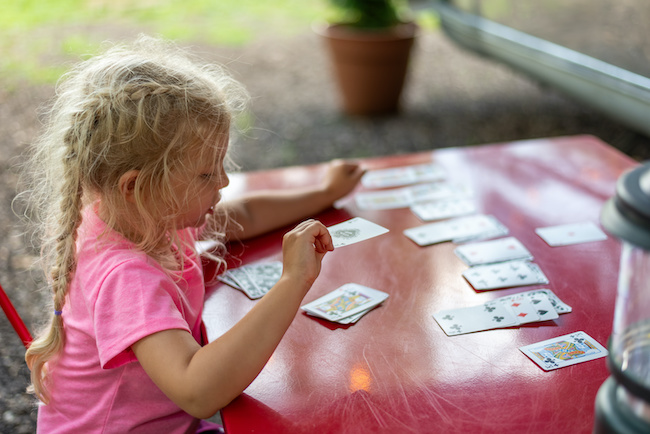Looking for a relaxing solo card game that boosts focus and strategy? Solitaire is a timeless one-player game that’s perfect for quiet moments at home or on the go. Whether it’s a rainy afternoon or a break during holiday festivities, this indoor activity is a fun way for kids (and adults!) to challenge their minds and enjoy a peaceful game session.
How to Play Solitaire
The goal of the game is to move all the cards to four foundation piles, sorted by suit and in ascending order (from Ace to King). Here’s how to set it up and play:
- Shuffle the deck and deal seven columns (known as the tableau).
- The first column has 1 face-up card.
- The second has 1 face-down card and 1 face-up on top.
- The third has 2 face-down cards, then 1 face-up.
- Continue this pattern until the seventh column has 6 face-down cards and 1 face-up card on top.
- Place the rest of the cards in a draw pile nearby.
- Begin building your foundation stacks above the tableau, one for each suit, starting with the Ace and continuing in ascending order up to the King.
- In the tableau, cards must be arranged in descending order and alternate colors (e.g., red Queen on black King). Only Kings can fill an empty tableau column.
- Draw from the pile when no more moves are available in the tableau. Use strategy to uncover face-down cards and work your way through the deck.
The game ends when all cards are correctly moved into the foundation piles—or if no more legal moves are possible.
For a hands-on challenge that builds focus and coordination, try our stack-and-balance Towering Game—a perfect solo or group activity!
Game Sheet
Here’s a quick overview to help you set up:
- Number of players: 1
- Recommended age: From 6 years old
- Supplies needed: A standard 52-card deck
- Setting: Indoors
- Game duration: About 20 minutes
Solitaire is ideal for solo play anywhere you can lay out a few rows of cards—at home, during travel, or even in the classroom as a focus-building activity.
Fun Tips and Variants
Want to keep things interesting? Try these ideas:
- Timed Challenge: See how fast you can solve the game!
- Three-Card Draw: Instead of drawing one card at a time, flip three at a time from the draw pile.
- Mini Solitaire: Use fewer columns (3–5) for younger kids or quicker games.
- Play with friends: Compete for the fastest time or fewest moves to win!
Rediscover a timeless classic with our active and educational Hopscotch Game—perfect for indoor or outdoor fun!

Why Kids Enjoy Solitaire
This game is calm, focused, and satisfying—perfect for kids who enjoy solo activities. It fosters independence, encourages critical thinking, and builds confidence through problem-solving.
Try this fun and simple coordination activity with the Bouncy Ball Toss Game—perfect for party fun or indoor play at home.
Educational Benefits of Solitaire
Solitaire isn’t just a way to pass the time. It’s a learning tool that helps children:
- Develop strategic thinking and decision-making
- Improve patience and concentration
- Enhance fine motor skills through card handling
- Build problem-solving skills by planning moves ahead
- Experience quiet, screen-free downtime that soothes the mind
Whether played occasionally or as part of a daily routine, Solitaire offers mental stimulation in a quiet, rewarding format.
Discover More Solo and Group Games for Kids
Looking for more solo play ideas? Explore our full list of fun indoor games for one that keep kids entertained and focused.
And for even more excitement, try our printable mystery and escape room kits—ready-to-use adventures created for kids aged 4 to 12, perfect for birthdays, holidays, or rainy-day fun!






